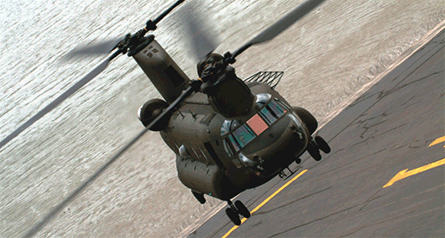Boeing's plant in Philadelphia rolled out the first CH-47 Chinook in 1961, overcame a business crisis four decades later and today stands among the most mature production lines in the aerospace industry.
Given these accomplishments, a seven-month streak of high-profile manufacturing breakdowns - with both criminal and accidental causes - have baffled the rotorcraft community.
In early January, a disgruntled assembly worker was sentenced to five months in jail for intentionally damaging a CH-47 last May. Another act of suspected sabotage discovered at the same time has never been resolved nor the culprit identified.
Misplaced tools and errant parts also have become a severe problem. Boeing ordered a safety stand-down on the CH-47 line in October and halted work on the V-22 line in November to investigate serious mistakes.
 |
|---|
© Boeing |
SPANNER IN THE WORKS?
Meanwhile, the Defense Contract Management Agency (DCMA) is investigating the discovery two weeks ago of a socket wrench inside an MH-47G after it was delivered to Blue Grass Army Depot in Richmond, Kentucky.
"I think all of these things added up in the mind of the DCMA, quite rightly," says Phil Dunford, Boeing's new vice-president and general manager for rotorcraft. "We weren't producing what he felt was a quality product and, quite rightly, a safe product when you think about some of things that happened on the line."
So far, the problems have not cost Boeing new business. In August, the US Army signed a $4.3 billion, multi-year deal for 181 new CH-47Fs and MH-47Gs.
However, with major foreign deals and the US Air Force's combat search and rescue helicopter contract still up for grabs, Boeing wants to resolve any concerns before any more damage is inflicted on its reputation. "We just can't get back in this situation again here in Philadelphia," Dunford says. "From the standpoint of Boeing's brand, it's not very good. From a customer's perspective, we don't want them to lose confidence in us."
To be sure, all manufacturers sometimes lose tools or deliver aircraft with small defects. But Dunford acknowledges that the Philadelphia site's record over the last year is "a lot worse than we've ever seen".
The timing of the incidents is also perplexing, coming only a few years after Boeing invested heavily in the Philadelphia site.
As recently as 2001, top Boeing military aircraft executives considered shutting the Philadelphia site permanently. CH-47 deliveries had dwindled to five aircraft a year and the V-22 faced cancellation after two flight-test crashes the year before.
Instead, Boeing decided to make a substantial commitment to revitalise both lines, investing $60 million in lean tooling and opening a new production line for the V-22 fuselage.
In short order, the V-22 programme survived to enter full-rate production, and the army began dramatically ramping up CH-47F production after 2004.
"I would argue that between 2001 and 2005-2006 we really came up a curve...to where I think we are a good performing organisation today," Dunford says.
However, Dunford acknowledges new investments lagged after 2005, creating an atmosphere that allowed mistakes in quality to start rising:
"We didn't invest as much because we had invested a lot already and there were so many new initiatives to keep going. So what happened was maybe we sank back a bit on that curve. Between 2005 and 2008 we settled back on our haunches."
OUTBREAK OF ERRORS
The sudden outbreak of errors late last year prompted Dunford to call a Saturday morning meeting of 200 managers. They were asked to submit their own ideas for fixing the problems and concluded that they were failing to follow quality control processes.
Since that meeting, there have been "significant changes to process", Dunford says. "There have been continued conversations with DCMA where we've iterated on our solution. And they've come back to us and told us how to reformulate those. All in all, what we've put in place now has satisfied DCMA that we have a better control over [foreign object debris] quality and tool control than we had last year."
Source: Flight International























